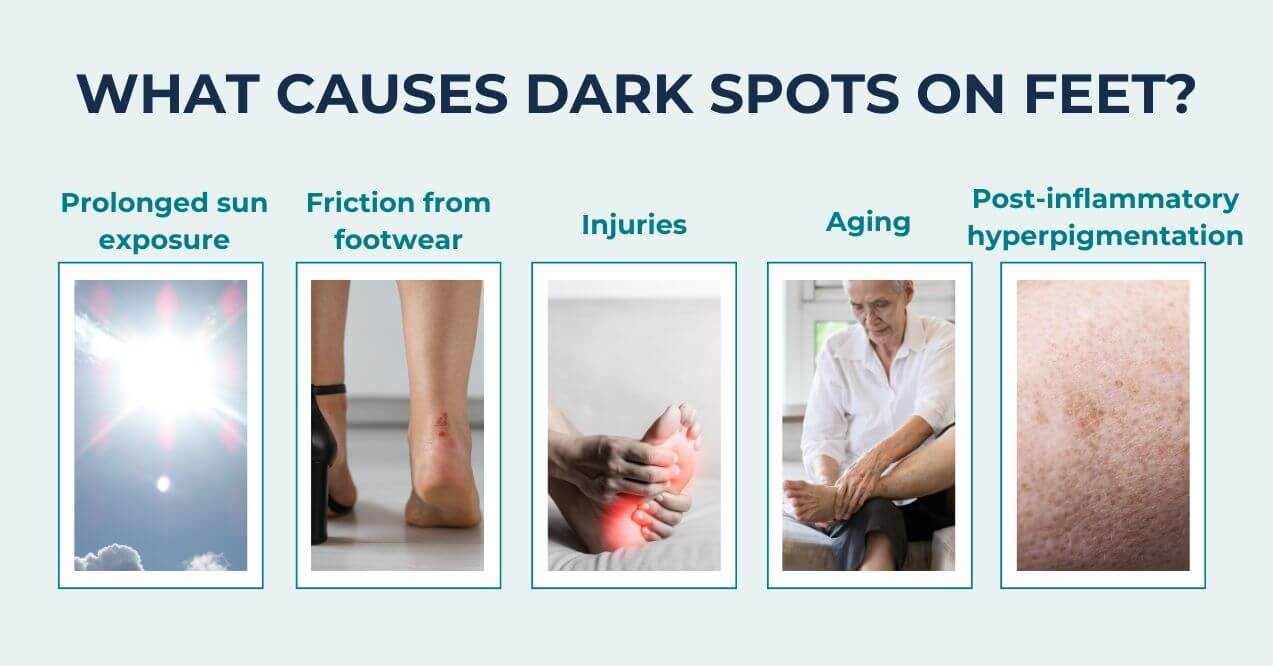How to Get Rid of Dark Spots on Feet: A Complete Guide
Looking for ways to get rid of dark spots on foot? Explore effective treatments, from home remedies to advanced medical options.


If you’re wondering how to get rid of dark spots on foot, you’re not alone. Dark spots on feet are a common skin concern that can affect individuals of all ages. These spots, often referred to as hyperpigmentation, may appear due to a variety of factors such as sun exposure, skin injuries, or aging. While they are generally harmless, many people seek solutions to reduce their appearance for cosmetic reasons.
This blog will explore what causes dark spots on feet and offer several ways to help alleviate or reduce their visibility, while also providing preventative tips to maintain even-toned skin.
What are Dark Spots on Feet?
Dark spots on the feet, commonly referred to as hyperpigmentation, occur when certain areas of the skin produce more melanin than usual. This results in patches of skin that are darker than the surrounding area. These spots can vary in size and color, ranging from light brown to almost black. Dark spots on the feet are usually harmless but may occasionally indicate underlying skin changes that require attention.
Unlike conditions such as bruising or infection, dark spots are typically flat and painless. They can appear on the soles, tops of the feet, or even around the toes, and they often develop gradually over time. It’s important to note that dark spots on the feet may also be confused with other foot conditions, such as nail fungus.
For those wondering what does toenail fungus look like, it usually appears as discolored and thickened toenails. Additionally, color changes may also occur due to a fungal infection. Therefore, understanding the difference between these conditions affecting the feet is crucial for selecting the appropriate care or prevention methods.
What Causes Dark Spots on Feet?

Dark spots on feet can develop due to various factors, primarily related to skin damage or irritation. Here are some common causes:
- Prolonged sun exposure – UV rays can stimulate excess melanin production, leading to hyperpigmentation on exposed areas like the feet.
- Friction from footwear – Tight or ill-fitting shoes cause repeated rubbing, leading to skin irritation and eventual darkening.
- Injuries – Minor cuts, blisters, or insect bites may leave behind dark spots during the healing process.
- Aging – Natural aging can slow down cell regeneration, leading to areas of darker skin.
- Post-inflammatory hyperpigmentation (PIH) – Skin discoloration that occurs after an injury or inflammation, commonly seen after healing from skin trauma.
How to Get Rid of Dark Spots on Feet?
Wondering how to get rid of dark spots on foot? Reducing the appearance of dark spots on your feet requires a combination of preventive care, home solutions, and professional treatments. Whether it’s a black spot on bottom of foot or other forms of hyperpigmentation, the following approaches can help reduce their appearance:
1. Sunscreen and Protective Clothing

One of the most effective ways to prevent dark spots is by using sunscreen with a high SPF, even on your feet. The skin on the feet is often neglected when applying sunscreen, but it is just as vulnerable to UV damage. Prolonged sun exposure without protection can cause or worsen dark spots. Choose a broad-spectrum sunscreen with at least SPF 30 and reapply it throughout the day if your feet are exposed to sunlight.
In addition to sunscreen, wearing protective clothing, such as socks and shoes that cover the feet, can help minimize exposure to harmful UV rays. This simple measure can help prevent new dark spots from forming.
2. Regular Skin Check-ups

Regular skin check-ups with a dermatologist are essential in managing hyperpigmentation and ensuring any changes in your skin are addressed early. A painless black spot on foot may seem harmless, but having it examined by a professional can rule out any underlying issues.
Dermatologists can assess the severity of the dark spots and recommend the most appropriate treatment based on your skin type and the underlying cause of the discoloration. Routine check-ups ensure that you’re taking proactive steps to maintain healthy skin and address any potential problems before they worsen.
3. Home Solutions

Several home remedies may help lighten dark spot on bottom of foot. While these methods are not guaranteed to eliminate the spots entirely, they can support a gradual reduction in appearance:
- Lemon juice – Known for its natural bleaching properties, lemon juice can help lighten dark spots. Apply it directly to the affected area for a few minutes before rinsing off.
- Aloe vera – Aloe vera gel is known for its soothing properties and may help reduce skin discoloration when applied regularly.
- Apple cider vinegar – The acidic nature of apple cider vinegar may help exfoliate the skin, promoting the reduction of dark spots over time.
Remember, these home solutions may be helpful for mild cases but should be used with caution to avoid skin irritation.
4. Medical Intervention

For more persistent dark spots or a black spot on the bottom of the foot that doesn’t respond to home remedies, medical treatments may be necessary. A dermatologist can recommend several advanced options, such as:
- Prescription creams – Dermatologists may prescribe topical creams containing ingredients like hydroquinone, retinoids, or corticosteroids, which can help lighten dark spots.
- Chemical peels – These involve the application of a chemical solution to the skin, which exfoliates the top layers, revealing newer, lighter skin underneath.
- Laser therapy – Laser treatments target melanin in the dark spots, breaking down pigment and helping to fade the spots over time.
Conclusion
If you’re wondering how to get rid of dark spots on foot, taking a proactive approach is key. Dark spots on the feet, often caused by sun exposure, friction, or skin injuries, can be managed through a combination of preventive measures, home solutions, and professional treatments.
By using sunscreen, staying vigilant with regular skin check-ups, and incorporating remedies like aloe vera and lemon juice, you can support your skin’s appearance. For persistent cases, dermatological interventions such as prescription creams or laser therapy may be necessary to reduce the visibility of dark spots.
Yes, dark spots can be reduced naturally using home remedies like lemon juice, aloe vera, and apple cider vinegar, which help lighten pigmentation. However, these methods take time, and results vary depending on the severity of the dark spots.
Dark spots on feet may fade over time, especially with proper care such as using sunscreen, home remedies, or medical treatments. However, some spots may persist depending on the cause and depth of pigmentation, requiring professional intervention for removal.
To prevent dark spots on feet, regularly apply sunscreen with high SPF, especially when exposed to sunlight. Wear protective clothing like socks and shoes, avoid tight footwear to reduce friction, and maintain routine skin care to minimize irritation and damage.
Sign up for our Healthy Living newsletter!
Advertisement. This site offers health, wellness, fitness and nutritional information and is designed for educational purposes only. You should not rely on this information as a substitute for, nor does it replace, professional medical advice, diagnosis, or treatment. If you have any concerns or questions about your health, you should always consult with a physician or other health-care professional. Do not disregard, avoid or delay obtaining medical or health related advice from your health-care professional because of something you may have read on this site. The use of any information provided on this site is solely at your own risk.










